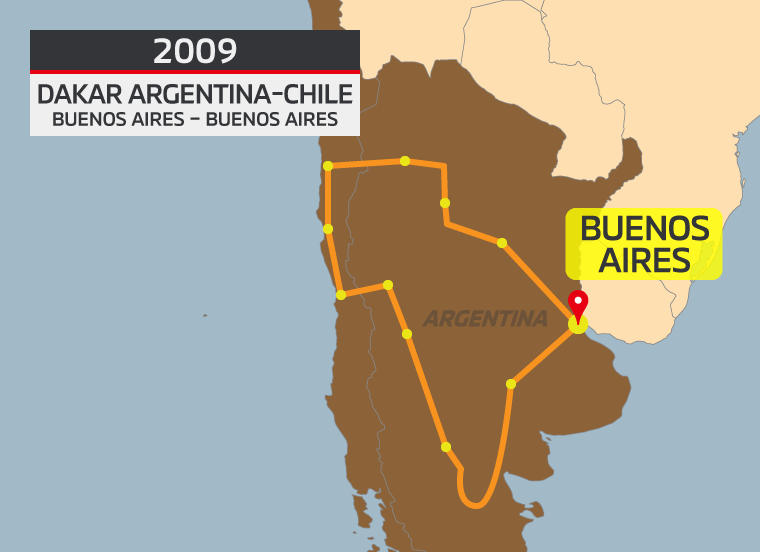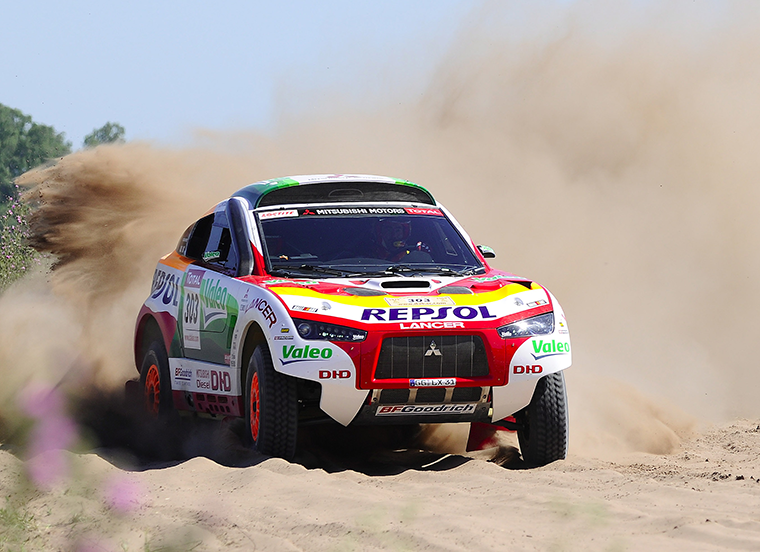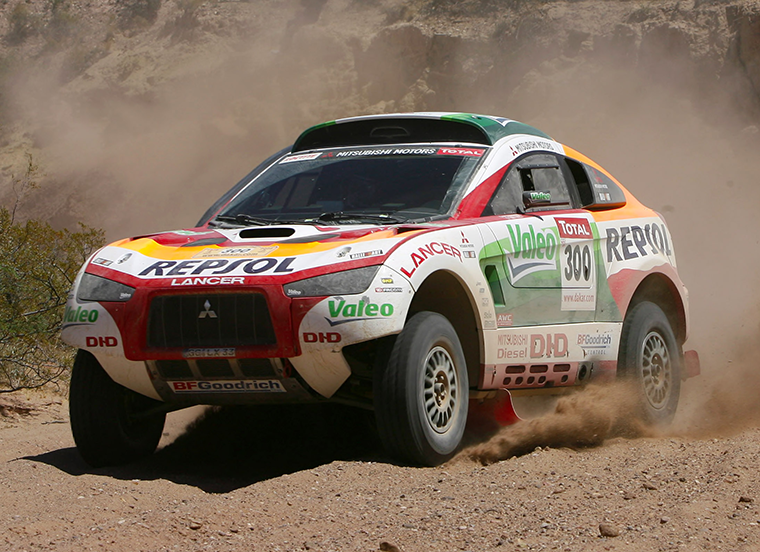
The 2008 event, which was to be the 30th edition of the rally, was cancelled in response to a request from the French government, claiming that the security situation in Mauritania had deteriorated and that it could not ensure the safety of the event. And in 2009, the Dakar Rally moved from Europe and Africa to South America. As Dakar founder Thierry Sabine said when the event first started, "I will show you the door to adventure. Only you can open it. I can take you along if you wish". For the new Dakar Rally in South America, MITSUBISHI MOTORS developed a new Super Production specification RACING LANCER that used the PAJERO/MONTERO EVOLUTION technology. The additional space freed up by the longer wheelbase has enabled the fuel tank to be positioned lower in the car and has consequently brought down the center of gravity. The body styling used carbon panels based on the design of the LANCER SPORTBACK. The powerplant was a V-type 6-cylinder 3-liter diesel turbo engine equipped with a two-stage turbo system that delivers high power throughout the entire range. Fitted with one large and one small turbine, this system synchronized them according to the engine revolution and load. Peak torque was 66.3 kg-m (650Nm), while maximum power output stood at 280PS. With the development of diesel technology, low compression ratio combustion and high-pressure fuel injection were to be tested through actual cross-country type competition, as well as the incorporation of carbon-neutral biofuel in diesel fuel.
The 31st event was held on new stages spread between Argentina and Chile, across the South American continent. The circular route covered a total distance of 9,574 km and competitive stages (SS) amounting to 5,652 km. The event started in Buenos Aires, the capital city of Argentina before striking south to the South Atlantic resort of Puerto Madryn. The route then headed west over the dusty trails up and over the Andes Mountains into Chile, travelling toward the north of the country across the Atacama Desert, then back across the Andes and into Argentina again to head to Buenos Aires via Córdoba, the country’s second largest city. Tough stages were scheduled, including those in the scorching Atacama Desert and Patagonian wild lands, as well as Andean mountain roads that reach an altitude of above 3,000 meters.


Aiming for an eighth consecutive victory to increase its total to 13, the MITSUBISHI MOTORS team lined up strong and experienced drivers such as Masuoka, Peterhansel, Alphand and Roma.
However, the team had to fight hard at the new Dakar Rally, which was the first to be held in South America. Masuoka, who had played a central role in the development of turbocharged diesel engines, showed off his impressive driving skills at the first day's special stage, but was then forced into an early retirement due to engine issue. Alphand also retired in the early stages of the event due to the sudden poor physical condition of his co-driver. In addition, Peterhansel was stopped by engine problems after crashing halfway through the rally. The sole surviving MITSUBISHI MOTORS driver was Roma who was lying in fourth in the latter half of the event, behind the three Volkswagens. By the end of the rally, he dropped back down the standings due to failing electrical power. Despite posting his first fastest time in the penultimate stage, he finished tenth overall, putting an end to the MITSUBISHI MOTORS team's series of seven consecutive victories. The overall victory went to Volkswagen’s de Villiers, followed by Miller, in a 1-2 finish for the German automaker. The third place was US driver Robby Gordon, driving a Hummer H3.

 The 2008 event, which was to be the 30th edition of the rally, was cancelled in response to a request from the French government, claiming that the security situation in Mauritania had deteriorated and that it could not ensure the safety of the event. And in 2009, the Dakar Rally moved from Europe and Africa to South America. As Dakar founder Thierry Sabine said when the event first started, "I will show you the door to adventure. Only you can open it. I can take you along if you wish". For the new Dakar Rally in South America, MITSUBISHI MOTORS developed a new Super Production specification RACING LANCER that used the PAJERO/MONTERO EVOLUTION technology. The additional space freed up by the longer wheelbase has enabled the fuel tank to be positioned lower in the car and has consequently brought down the center of gravity. The body styling used carbon panels based on the design of the LANCER SPORTBACK. The powerplant was a V-type 6-cylinder 3-liter diesel turbo engine equipped with a two-stage turbo system that delivers high power throughout the entire range. Fitted with one large and one small turbine, this system synchronized them according to the engine revolution and load. Peak torque was 66.3 kg-m (650Nm), while maximum power output stood at 280PS. With the development of diesel technology, low compression ratio combustion and high-pressure fuel injection were to be tested through actual cross-country type competition, as well as the incorporation of carbon-neutral biofuel in diesel fuel.
The 2008 event, which was to be the 30th edition of the rally, was cancelled in response to a request from the French government, claiming that the security situation in Mauritania had deteriorated and that it could not ensure the safety of the event. And in 2009, the Dakar Rally moved from Europe and Africa to South America. As Dakar founder Thierry Sabine said when the event first started, "I will show you the door to adventure. Only you can open it. I can take you along if you wish". For the new Dakar Rally in South America, MITSUBISHI MOTORS developed a new Super Production specification RACING LANCER that used the PAJERO/MONTERO EVOLUTION technology. The additional space freed up by the longer wheelbase has enabled the fuel tank to be positioned lower in the car and has consequently brought down the center of gravity. The body styling used carbon panels based on the design of the LANCER SPORTBACK. The powerplant was a V-type 6-cylinder 3-liter diesel turbo engine equipped with a two-stage turbo system that delivers high power throughout the entire range. Fitted with one large and one small turbine, this system synchronized them according to the engine revolution and load. Peak torque was 66.3 kg-m (650Nm), while maximum power output stood at 280PS. With the development of diesel technology, low compression ratio combustion and high-pressure fuel injection were to be tested through actual cross-country type competition, as well as the incorporation of carbon-neutral biofuel in diesel fuel.
 Aiming for an eighth consecutive victory to increase its total to 13, the MITSUBISHI MOTORS team lined up strong and experienced drivers such as Masuoka, Peterhansel, Alphand and Roma.
However, the team had to fight hard at the new Dakar Rally, which was the first to be held in South America. Masuoka, who had played a central role in the development of turbocharged diesel engines, showed off his impressive driving skills at the first day's special stage, but was then forced into an early retirement due to engine issue. Alphand also retired in the early stages of the event due to the sudden poor physical condition of his co-driver. In addition, Peterhansel was stopped by engine problems after crashing halfway through the rally. The sole surviving MITSUBISHI MOTORS driver was Roma who was lying in fourth in the latter half of the event, behind the three Volkswagens. By the end of the rally, he dropped back down the standings due to failing electrical power. Despite posting his first fastest time in the penultimate stage, he finished tenth overall, putting an end to the MITSUBISHI MOTORS team's series of seven consecutive victories. The overall victory went to Volkswagen’s de Villiers, followed by Miller, in a 1-2 finish for the German automaker. The third place was US driver Robby Gordon, driving a Hummer H3.
Aiming for an eighth consecutive victory to increase its total to 13, the MITSUBISHI MOTORS team lined up strong and experienced drivers such as Masuoka, Peterhansel, Alphand and Roma.
However, the team had to fight hard at the new Dakar Rally, which was the first to be held in South America. Masuoka, who had played a central role in the development of turbocharged diesel engines, showed off his impressive driving skills at the first day's special stage, but was then forced into an early retirement due to engine issue. Alphand also retired in the early stages of the event due to the sudden poor physical condition of his co-driver. In addition, Peterhansel was stopped by engine problems after crashing halfway through the rally. The sole surviving MITSUBISHI MOTORS driver was Roma who was lying in fourth in the latter half of the event, behind the three Volkswagens. By the end of the rally, he dropped back down the standings due to failing electrical power. Despite posting his first fastest time in the penultimate stage, he finished tenth overall, putting an end to the MITSUBISHI MOTORS team's series of seven consecutive victories. The overall victory went to Volkswagen’s de Villiers, followed by Miller, in a 1-2 finish for the German automaker. The third place was US driver Robby Gordon, driving a Hummer H3.

